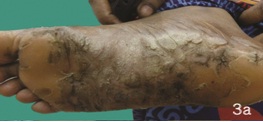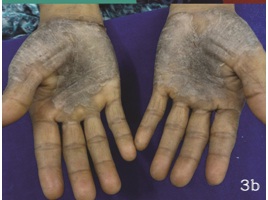Palmoplantar Psoriasis- Ahead in the Race-A Prospective Study from a Tertiary Health Care Centre in South India
Anandan Venkatesan1, Ramesh Aravamudhan2, Saradha Kandasamy Perumal3, Rajkumar Kannan4, Vanathi Thirunavukkarasu5, Shubhra Shukla6
1 Professor and Head of Department, Department of Dermatology, Government Stanley Medical College & Hospital, Chennai, India.
2 Additional Professor, Department of Dermatology, Government Stanley Medical College & Hospital, Chennai, India.
3 Assistant Professor, Department of Dermatology, Government Stanley Medical College & Hospital, Chennai, India.
4 Assistant Professor, Department of Dermatology, Government Stanley Medical College & Hospital, Chennai, India.
5 Assistant Professor, Department of Dermatology, Government Stanley Medical College & Hospital, Chennai, India.
6 Post Graduate, Department of Dermatology, Government Stanley Medical College & Hospital, Chennai, India.
NAME, ADDRESS, E-MAIL ID OF THE CORRESPONDING AUTHOR: Dr. Anandan Venkatesan, Professor and Head of Department, Department of Dermatology Govt. Stanley Medical College & Hospital, Royapuram, Chennai -600 001, Tamil Nadu, India. Email : dermanandan@gmail.com
Background: Psoriasis is a common and chronic T cell mediated skin disorder with varied clinico-morphological types. Most of the published studies have reported chronic plaque type psoriasis to be the commonest type.
Aim: To find the incidence of palmoplantar psoriasis in a tertiary health care centre in South India.
Materials and Methods: A prospective study done over a period of six months recruiting the patients attending the Dermatology out-patient department in a tertiary health care centre.
Results: Incidence of palmoplantar psoriasis was found to be highest among all morphological forms of psoriasis.
Conclusion: Incidence of palmoplantar psoriasis is under-expressed. It is actually ahead in the race.
Introduction
Psoriasis is a common, chronic, disfiguring, inflammatory and proliferative condition of skin in which both genetic and environmental influences play a critical role. Apart from skin, it affects nails, joints and is now being described as a metabolic disorder [1]. The characteristic lesions consist of red, scaly, well demarcated plaques mainly over extensors and scalp. Prevalence of psoriasis varies in different parts of the world. According to published reports, prevalence in different populations may vary from 0% to 11.8% [2,3]. In India, in a study by Okhandiar et al., [4], incidence of psoriasis was found to be 1.02%. In another study by Bedi [5], the incidence was found to be 2.8%. A study from tertiary health care centre in north India [6], showed that psoriasis accounted for 2.3% of all dermatology outpatients.There are only few studies from India which have analysed the clinical spectrum of the disease in psoriasis patients [7,8]. In most of the studies, most common type of psoriasis reported is chronic plaque type psoriasis or psoriasis vulgaris.In the study done by Bedi [5], chronic plaque type psoriasis was found to be the most common type (90% cases), followed by palmoplantar psoriasis. Chronic plaque type psoriasis (93%) was also the most common clinical phenotype in the study done by Kaur et al., [6].
Although palmoplantar psoriasis produces considerable social and functional disability, there is paucity of studies on the incidence of palmoplantar psoriasis. Palmoplantar psoriasis is shown to constitute 3-4% of all psoriasis cases in most of the studies conducted [9]. Our study is first of its type done in South India to find the incidence of palmoplantar psoriasis and compare its incidence with other forms.
Materials and Methods
The study was hospital based cross sectional study done over a period of six months from January 2014 to June 2014 in the department of dermatology at Government Stanley Medical College and Hospital.All the cases included were newly diagnosed cases. The study did not include palmoplantar pustulosis. Proper history taking at first visit regarding onset,duration, progression of disease and complains was done and data regarding age, sex, family history, nail involvement, morphology of lesions, exacerbating or relieving factors, and histological findings in cases where biopsy was required was collected in each case. This was followed by thorough dermatological examination by the trained dermatologists before putting up the diagnosis of palmoplantar psoriasis. Diagnosis of psoriasis is usually clinical as characterised by typical scaly patches with silvery scales which is accentuated on scratching. Involvement of instep region over the soles is characteristic of psoriasis. However, diagnosis was doubtful in 12% cases, all these cases were subjected to biopsy and scrapping for fungus to rule out other dermatoses. Collected data was classified, tabulated and analysed by using appropriate statistical tools (percentages and ratios) as per requirement of the present study and interpretations/conclusions were made accordingly.
Results
Total number of new psoriasis patients attending the outpatient department during this period was 403. This was around 2.4% of the total cases coming to the outpatient department [Table/Fig-1] and included various types of psoriasis like chronic plaque type, palmoplantar psoriasis, scalp psoriasis, pustular psoriasis, flexural psoriasis, nail psoriasis and erythrodermic psoriasis. Among these, 59.8% (241) were male and 40.2% (162) were female, showing slight male preponderance. Around 68% patients were in 20-40 y age group & 30% patients in 40-60 y age group, remaining 2% consisted of <20 y or > 60 y patients.
Psoriasis incidence in patients attending dermatology outpatient department

In our study, out of total 403 psoriasis cases, palmoplantar psoriasis constituted about 59% (237) cases, [Table/Fig-2] which was a huge number, followed by chronic plaque type psoriasis. The ratio between male and female patients was 1.48:1. The lesions were bilaterally symmetrical in almost 90% patients. However, in some there was involvement of dominant hand. Over the palms plaques mainly present over pressure points with relative sparing of central palm. Over the soles, instep and sides of feet were characteristically involved. In most of the cases the disease was symptomatic causing irritation, pain, difficulty in walking or working. Involvement of both palms and soles was more common than either of them alone. The skin lesions were associated with the psoriatic nail changes in 39% patients.
Incidence of various morphological patterns of psoriasis in our setup
| Morphological pattern | Percentage |
|---|
| Palmoplantar Psoriasis | 59% |
| Chronic plaque type Psoriasis | 38% |
| Scalp Psoriasis | 1% |
| Pustular Psoriasis | 0.3% |
| Erythroderma | 0.5% |
| Others (flexural, psoriatic arthritis,guttate) | 1.2% |
Discussion
If we look for Psoriasis prevalence studies in India, they are mostly Hospital based. In a comprehensive study done by Okhandiar et al., [4], it was found that the incidence of psoriasis among total skin patients ranged between 0.44 and 2.2%.In another study from tertiary health care centre from North India [6], psoriasis patients accounted for 2.3% of the total Dermatology outpatients. This corresponds with the incidence rate of psoriasis seen in our study.In the same study in a tertiary health care study in North India,it was shown that out of the total psoriasis patients 67% were men and 33% were women, male to female ratio being 2.03:1.In our study, this ratio was 1.48: 1.
In our study, out of total 403 cases, palmoplantar psoriasis constituted about 59% (237) cases [Table/Fig-2] in contrast to previous studies done regarding clinical spectrum of psoriasis. Chronic plaque type psoriasis ranked second with 38%. In a study done by Bedi [5], he concluded that most common type is chronic plaque type psoriasis and second most common is palmoplantar psoriasis. Okhandiar et al., [4] collected epidemiological data of 116 psoriais patients from various medical colleges. They found that the extensors were the most common site of involvement followed by the scalp.There was slight male preponderance with male: female ratio of 1.48:1 in our study. Similarly male patients outnumbered female patients in a study done by Khandpur S [10] on palmoplantar psoriasis. In contrast in Kumar et al., [11] and Chopra et al., [12] studies, both men and women were almost equally involved.
Most of the patients presenting with palmoplantar psoriasis were manual labourers (32%) or drivers (15%), farmers (14%) or housewives (30%) [12]. However, it was interesting to see a respectable number of patients belonged to office class (9%). In around 10% patients the disease was asymptomatic.
However, most patients complained irritation (40%), fissuring (30%), difficulty in walking (48%) difficulty in manual work (33%) and pain (16%) [13,14].
Both palms and soles involvement was seen in 52% cases (123). Exclusive palmar involvement was present in 28% cases (66) while only plantar involvement in 20% (47) cases. In Kumar et al., study [11], plantar involvement was twice as common as palmar involvement. Around 18% patients in our study showed evidence of psoriasis at other sites.
Psoriasis over palms and soles may present as typical scaly patches on which a fine silvery scale can be evoked by scratching [Table/Fig-3a] or as less well-defined plaques resembling hyperkeratotic eczema [Table/Fig-3b] or as pustulosis. Sparing of skin creases over palms may be seen. Increased pigmentation of skin often accompanies. Associated nail changes in form of pitting, thickening of nail plate, subungual hyperkeratosis were seen in about 39% patients. Nail involvement was present in 23.4% of the cases by Chopra et al., [12].
Clinical picture of Palmoplantar psoriasis- typical scaly patches

Clinical picture of Palmoplantar psoriasis – resembling hyperkeratotic eczema

The diagnosis of palmoplantar psoriasis may be missed, its differentiation from other morphologically similar conditions like hyperkeratotic eczema, dermatophytosis and contact dermatitis, is of prime importance. Dermatophytosis is usually unilateral and responds easily to antifungals. Hyperkeratotic eczema sometimes poses difficulty to distinguish and may overlap with psoriasis. Usually the lesions are not well-demarcated as in psoriasis and degree of erythema is also less. Presence of hyperkeratotic lesions over the knuckles favours psoriasis. Term psoriasiform eczema is applied when the conditions overlap clinically and histologically.
Conclusion
The incidence of palmoplantar psoriasis is under-expressed. It is actually ahead in the race. More studies are required to further validate the changing scenario.
[1]. Nisa N, Qazi MA, Prevalence of metabolic syndrome in patients with psoriasis Indian J Dermatol Venereol Leprol 2010 76(6):662-65. [Google Scholar]
[2]. Kaur I, Kumar B, Sharma VK, Kaur S, Epidemiology of psoriasis in a clinic from north India Indian J Dermatol Venereol Leprol 1986 52:208-12. [Google Scholar]
[3]. Swanbeck G, Inerot A, Martinsson T, Wahlström J, A population genetic study of psoriasis Br J Dermatol 1994 131:32-39. [Google Scholar]
[4]. Okhandiar RP, Banerjee BN, Psoriasis in the tropics: An epidemiological survey J Indian Med Assoc 1963 41:550-56. [Google Scholar]
[5]. Bedi TR, Psoriasis in north India. Geographical variations Dermatologica 1977 155:310-14. [Google Scholar]
[6]. Kaur I, Handa S, Kumar B, Natural history of psoriasis: a study from the Indian subcontinent J Dermatol 1997 24:230-34. [Google Scholar]
[7]. Dogra S, Yadav S, Psoriasis in India: Prevalence and pattern Indian J Dermatol Venereol Leprol 2010 76:595-601. [Google Scholar]
[8]. Ram S, Indian psoriasis research: An impact assessment through bibliometric studies J Sci Res 2013 2:126-31. [Google Scholar]
[9]. Farber EM, Nall ML, Natural history of psoriasis in 5600 patients Dermatologica 1974 148:1-18. [Google Scholar]
[10]. Khandpur S, Singhal V, Sharma VK, Palmoplantar involvement in psoriasis: A clinical study Indian J Dermatol Venereol Leprol 2011 77:625 [Google Scholar]
[11]. Kumar B, Saraswat A, Kaur I, Palmoplantar lesions in psoriasis: A study of 3065 patients Acta Derm Venereol 2002 82:192-95. [Google Scholar]
[12]. Chopra A, Maninder Gill SS, Hyperkeratosis of palms and soles: Clinical study Indian J Dermatol Venereol Leprol 1997 63:85-88. [Google Scholar]
[13]. Suman Babu PS, Reddy Shankargowda I, Clinico Epidemiological Study of Palmoplantar Psoriasis Journal of Evidence Based Medicine and Healthcare 2014 1(7):656-60. [Google Scholar]
[14]. Sampogna F, Gisondi P, Melchi C, Amerio P, Girolomoni G, Abeni D, Prevalence of symptoms experienced by patients with different clinical types of psoriasis Br J Dermatol 2004 151:594-99. [Google Scholar]